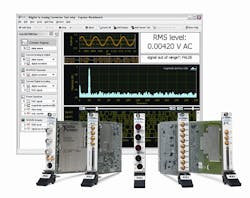Is Modular Really More For Less?
Older engineers may fondly remember an early job and that first stroll past a test bench. Those impressive 19-in. instrument racks were filled with the tools of the trade, including signal generators, oscilloscopes, spectrum analyzers, and maybe even classic vector network analyzers (VNAs) from earlier times, such as the HP 8409 and HP 8510 VNAs from Hewlett-Packard Co. (formerly Agilent Technologies and now Keysight Technologies). The large racks and heavy instruments were necessary parts of research and production testing at RF and microwave frequencies and represented major investments for high-frequency companies.
But engineers now have a very real and practical option for making high-frequency measurements, in the form of modular equipment—such as AXIe and PXI/PXIe modules that can slide in and out of a rack-mount chassis as different measurement functions are needed, keeping things compact. Many of the major test-instrument suppliers have embraced these modular instrument formats and are offering many different measurement functions in modular form. But are they that much better than the old benchtop format of RF/microwave test instruments?
As noted recently in Microwaves & RF, the most obvious difference between traditional benchtop instruments and modular instruments is size. One reason is that each benchtop instrument requires its own power supply, while modular test instruments can tap into the power of a chassis’ supply. Benchtop instruments provide their own control panels, and many also include display screens. Modular instruments work on an instrument bus, such as PCI or PCI Express, under the command of a personal computer (PC) and measurement software.
The small size of these modules makes for compact test stations with high-density measurement capabilities. These are truly automated test systems that can fit on a benchtop and still leave room for a device under test (DUT) and test fixture, versus a traditional rack-mount automatic test system that typically occupies a good portion of floor space and generally remains in that place, with engineers coming to it rather than the other way around. Especially as modern communications testing heads towards more multiple-channel and multiple-input, multiple-output (MIMO) designs that must be tested, benchtop instrument systems with multiple test signal sources can grow quite large as the number of channels to be tested grows.
PXI/PXIe modular instruments and their high-speed PCI/PCIe communications busses also provide tremendous benefits in terms of the synchronization of multiple-carrier test signals for such applications as testing MIMO components. The excellent timing characteristics and lack of delays in a PCI/PCIe make possible extremely tight synchronization of multiple test signal sources. In contrast, automated benchtop instruments that are being synchronized for multiple-signal testing by means of a General Purpose Instrument Bus (GPIB) are subject to timing errors because of latency inherent in a GPIB communications line.
In addition, newer modular arbitrary waveform generators are low-noise RF/microwave signal sources designed around the latest high-speed data converters and low-noise clock sources to generate low-phase-noise test signals that can achieve not only tight synchronization of multiple signals, but impressively fast switching speeds to handle the large number of measurements associated with production testing. For some extremely demanding performance requirements, such as low signal generator phase noise, a benchtop signal generator that employs a larger YIG-tuned oscillator known for their outstanding phase noise, may be preferred over a more compact modular signal generator, with some compromises in frequency tuning speed for the slower tuning YIG oscillator.
In addition to fitting a great deal of functionality within small instrument modules, modular AXIe and PXI/PXIe test instruments offer tremendous flexibility within those slide-in slots on an instrument chassis. If more test signals are needed for testing a multiple-channel communications device or component, and a card slot is available, it is simply a matter of sliding in another signal source module. Even if no slots are available on one chassis, another chassis can be added and connected via PCI/PCIe bus to provide slots as needed for additional instrument modules. These modular instruments are also designed for lower power consumption than stand-alone benchtop instruments and their dedicated power supplies, which can make a difference in a firm’s utility bills over many hours of testing.
Those older engineers referred to earlier may have a preference for certain benchtop instruments because of familiarity with having often used those instruments. But the many benefits and advantages of modular RF/microwave test instruments, along with typically lower prices compared to their benchtop counterparts, are making modular test gear a “no brainer” decision for those faced with a choice between benchtop and modular test instruments.
About the Author
Jack Browne Blog
Jack Browne, Technical Contributor, has worked in technical publishing for over 30 years. He managed the content and production of three technical journals while at the American Institute of Physics, including Medical Physics and the Journal of Vacuum Science & Technology. He has been a Publisher and Editor for Penton Media, started the firm’s Wireless Symposium & Exhibition trade show in 1993, and currently serves as Technical Contributor for that company's Microwaves & RF magazine. Browne, who holds a BS in Mathematics from City College of New York and BA degrees in English and Philosophy from Fordham University, is a member of the IEEE.
